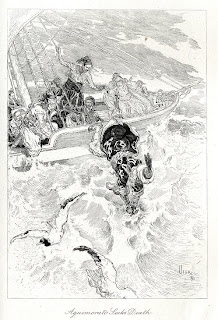It was mentioned about 'upgrading' pen and ink rendering to Fine Art... what would this mean, and why be wanting to do this? the issue has to do with theming, something which most artists are only dimly aware of, and rarely ever having had any understanding of its nature, let alone of its importance... in visualizing the universe, the world around oneself and/or especially the world within the four corners of the canvas [whether actual canvas or not, but a convenient metaphor for the support on which the rendering is done], there is, for the artist, a necessity, whether consciously seen or not, to sift and choose among all the possibilities, what is considered by the artist of primary IMPORTANCE - indeed, within that universe of creation, by the nature of this choosing, everything which is deemed of importance enough to include is as such metaphysical in importance, precisely because in the choosing, whatever is included assumes fundamental values to the artist... why? as I see it, it is because in creating a work of art, especially Fine Art, an artist is involved in 'selective re-presentation', of necessity - because not everything CAN be included, thus what is, HAS to assume prime importance, whether consciously considered or not... further, the more an artist consciously is aware of this process, the more an artist deliberately strives to arrange and compose according to this premise - the more consistent the end result will be, and the greater the work will be in consequence...
This is, actually, a logical extension to the illustrating [which, of course, also dealt with theming, but from the standpoint of the story and not the rendering itself]... here, tho, it is raised to the work itself, for the work itself, so that one can contemplate the work and grasp that there are layers to it [like the proverbial onion], which in essence is what elevates it beyond mere fancy sketching, or even crafted drawing, to Fine Art - just as is the same with the better works in other mediums...
 When the term 'ink painting' is mentioned, it usually has referred to Asian ink works... when used today, it can be in a similar vein, or, as seen with Gao Xingjian, splotches of b/w decorative work... but, as also seen, it can be crisp in color, and utilizing architecture as part... there is, after all, no reason ink cannot be used with brushes as well as pens...
When the term 'ink painting' is mentioned, it usually has referred to Asian ink works... when used today, it can be in a similar vein, or, as seen with Gao Xingjian, splotches of b/w decorative work... but, as also seen, it can be crisp in color, and utilizing architecture as part... there is, after all, no reason ink cannot be used with brushes as well as pens... 




















.JPG)
